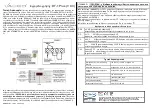• In high speed mode, the core and bus clock frequencies are determined by the
clockDivider configuration value.
• The core clock divider is set directly from the inverted value of the clockDivider.
• The bus clock divider is set to 1, unless the resulting bus clock frequency would be
greater than the maximum supported value. In this case, the bus clock divider is
increased until the bus clock frequency is at or below the maximum.
• Note that the maximum baud rate of serial peripherals is related to the core and bus
clock frequencies. To achieve the desired baud rates, high speed mode should be
enabled in BCA.
22.3.5 Bootloader Entry Point / API Tree
To run the Kinetis Bootloader, a user application simply calls the runBootloader function.
To get the address of the entry point, the user application reads the word containing the
pointer to the bootloader API tree at offset 0x1C of the bootloader's vector table. The
vector table is placed at the base of the bootloader's address range, which for the ROM is
0x1C00_0000; the API tree pointer is at address 0x1C00_001C.
The bootloader API tree is a structure that contains pointers to other structures, which
have the function and data addresses for the bootloader. The bootloader entry point is
always the 1st word of the API tree.
typedef struct BootloaderTree
{
void (*runBootloader)(void *arg); //!< Function to start the bootloader
executing.
standard_version_t version; //!< Bootloader version number.
const char *copyright; //!< Copyright string.
const bootloader_context_t *runtimeContext; //!< Pointer to the bootloader's runtime
context.
const flash_driver_interface_t *flashDriver; //!< Flash driver API.
const aes_driver_interface_t *aesDriver; //!< AES driver API.
} bootloader_tree_t;
The prototype of the entry point is:
void run_bootloader(void * arg);
The
arg
parameter is currently unused, and is intended for future expansion (for example,
passing options to the bootloader). To ensure future compatibility, a value of NULL
should be passed for
arg
.
Example: code to get the entry pointer address from the ROM and start the bootloader.
NOTE
This entry must be called in supervisor (privileged) mode.
// Variables
Chapter 22 Kinetis ROM Bootloader
Kinetis KE1xZ256 Sub-Family Reference Manual, Rev. 3, 07/2018
NXP Semiconductors
477
Summary of Contents for Kinetis KE1xZ256
Page 2: ...Kinetis KE1xZ256 Sub Family Reference Manual Rev 3 07 2018 2 NXP Semiconductors...
Page 178: ...Usage Guide Kinetis KE1xZ256 Sub Family Reference Manual Rev 3 07 2018 178 NXP Semiconductors...
Page 356: ...Usage Guide Kinetis KE1xZ256 Sub Family Reference Manual Rev 3 07 2018 356 NXP Semiconductors...
Page 410: ...Interrupts Kinetis KE1xZ256 Sub Family Reference Manual Rev 3 07 2018 410 NXP Semiconductors...
Page 604: ...Usage Guide Kinetis KE1xZ256 Sub Family Reference Manual Rev 3 07 2018 604 NXP Semiconductors...
Page 634: ...Usage Guide Kinetis KE1xZ256 Sub Family Reference Manual Rev 3 07 2018 634 NXP Semiconductors...
Page 674: ...Usage Guide Kinetis KE1xZ256 Sub Family Reference Manual Rev 3 07 2018 674 NXP Semiconductors...
Page 820: ...Usage Guide Kinetis KE1xZ256 Sub Family Reference Manual Rev 3 07 2018 820 NXP Semiconductors...
Page 1030: ...Usage Guide Kinetis KE1xZ256 Sub Family Reference Manual Rev 3 07 2018 1030 NXP Semiconductors...
Page 1052: ...Usage Guide Kinetis KE1xZ256 Sub Family Reference Manual Rev 3 07 2018 1052 NXP Semiconductors...
Page 1066: ...Usage Guide Kinetis KE1xZ256 Sub Family Reference Manual Rev 3 07 2018 1066 NXP Semiconductors...
Page 1268: ...Usage Guide Kinetis KE1xZ256 Sub Family Reference Manual Rev 3 07 2018 1268 NXP Semiconductors...
Page 1314: ...Usage Guide Kinetis KE1xZ256 Sub Family Reference Manual Rev 3 07 2018 1314 NXP Semiconductors...
Page 1316: ...Kinetis KE1xZ256 Sub Family Reference Manual Rev 3 07 2018 1316 NXP Semiconductors...


















